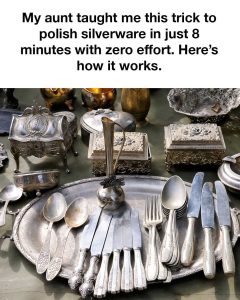Silverware, with its timeless charm and polished beauty, brings an unmistakable elegance to every meal. Whether it’s an everyday family dinner or a special holiday gathering, shining silver utensils and serving pieces can truly elevate the dining experience. However, anyone who owns silverware knows all too well the challenge that comes with keeping it gleaming. Over time, silver loses its luster and becomes coated with a dull, dark tarnish that can make even the most beautiful pieces look neglected. For years, I put off polishing my silverware, dreading the process that I associated with hours of tedious scrubbing and the overwhelming scent of strong, chemical-heavy polishes. It always felt like more hassle than it was worth—until everything changed.

One day, while visiting my aunt, I happened to compliment the shine of her silver tea set. It looked like it had just come out of a high-end showroom. I mentioned how difficult it was to maintain such brilliance, and that’s when she leaned in, smiled, and said she had a little secret. What she shared with me turned my silver-cleaning routine upside down in the best way possible. Gone were the days of sore arms and wasted afternoons. Now, I can restore my silverware to a like-new sparkle in just eight minutes—with minimal effort and no toxic chemicals. And the best part? You probably already have everything you need at home.
But before jumping into this miraculous method, it’s worth understanding why silver tarnishes in the first place. The dull, dark coating that we call tarnish is actually a layer of silver sulfide, which forms when silver reacts with sulfur-containing compounds in the air. This natural chemical reaction slowly transforms the shiny surface of silver into a lackluster one. Most people turn to store-bought silver polishes to combat this, but these products often contain harsh ingredients and require significant elbow grease to get results. That’s where my aunt’s method comes in—it works through a different kind of chemical reaction, one that’s simple, safe, and incredibly effective.
Her technique relies on a basic electrochemical process that uses aluminum foil, baking soda, and boiling water to reverse the tarnish. Yes, you read that right—no fancy gadgets, no toxic polish. Just a few common kitchen items can make your silver shine like new. Here’s what you’ll need: a non-metallic container like a glass or plastic bowl, a sheet of aluminum foil, a few tablespoons of baking soda, boiling water, and a pair of tongs or a spoon for safe handling. The process is straightforward. First, line the bottom of your container with the shiny side of the aluminum foil facing up. Next, sprinkle a generous amount of baking soda across the foil. Then, arrange your tarnished silverware so that each piece is in direct contact with the foil. This contact is crucial for the reaction to take place. Once everything is set, pour enough boiling water over the silverware to fully submerge it. Almost immediately, you’ll start to see the tarnish fade away as the magic begins to work.
After letting your silver soak for five to eight minutes, carefully remove each piece with the tongs or spoon. Rinse them under cool running water to remove any lingering baking soda, then dry thoroughly with a soft cloth. If desired, a gentle buff with the cloth will add even more shine. The science behind this method is fascinating. The aluminum and baking soda create a reaction that transfers the sulfur atoms from the silver to the aluminum, effectively reversing the tarnish without removing any of the silver itself. This means your silverware is not only clean but preserved. Unlike abrasive polishing methods, this approach protects the integrity of your silver.
There are so many reasons to love this method beyond just the dazzling results. First and foremost, it avoids harsh chemicals entirely, making it safe for you, your family, and even the environment. It’s also remarkably quick—no more wasting an afternoon polishing individual forks and spoons. Best of all, this approach is incredibly gentle. Because you’re not rubbing or scraping the surface, your silver is less likely to become scratched or worn down over time. And did I mention how cost-effective it is? With just a bit of foil and baking soda, you’ll get results that rival expensive professional cleanings.
There are a few tips worth keeping in mind. Always use a non-metallic container, as metal can interfere with the chemical reaction. Also, while this method is ideal for solid silver or sterling silver pieces, it’s not recommended for silver-plated items, as the reaction could potentially damage the thin silver coating. And even though this method does a fantastic job of removing tarnish, a light, occasional hand polish with a soft cloth in between treatments will help your silver maintain its brightness even longer.
Thanks to my aunt’s advice, what was once a dreaded chore is now a quick and satisfying task. I no longer hide away my silverware for fear of facing hours of cleaning. Instead, I use it proudly, knowing that keeping it looking beautiful is no longer a burden. In just eight minutes, I can take a drawer full of tarnished utensils and transform them into table-ready pieces that sparkle like they did on the day I got them. It’s amazing how something so simple can make such a big difference. So if your silverware has lost its shine, give this method a try. You’ll be pleasantly surprised at how effortless it is to bring back that brilliant gleam—and you might even start looking forward to polishing silver.





